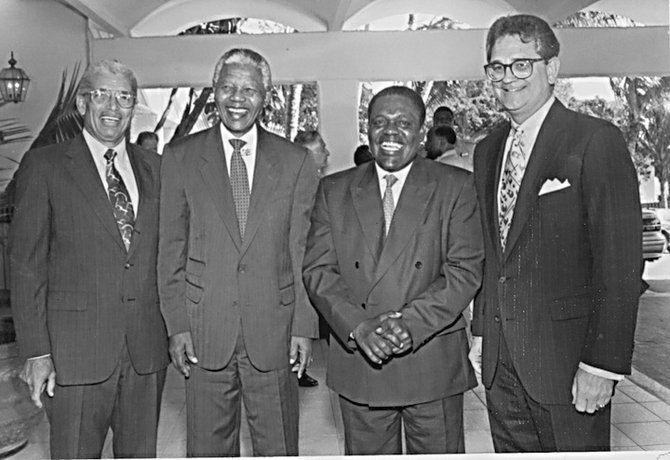IN this picture published on January 5, 1994, African National Congress President Nelson Mandela visited Resorts International’s Paradise Island and lunched with Prime Minister Hubert Ingraham and other cabinet ministers. The group were hosted in a private suite by senior vice presidents Michael J Williams and J Barrie Farrington. After lunch, Mr Mandela chatted informally with Mr Williams and Mr Farrington about Sun International’s plans for the Paradise Island properties. The rest of the afternoon was spent touring Paradise Island Resort and visiting with the management of the Paradise Island Airpot, Gold Club, Ocean Club and Paradise, Paradise. From left: Mr Farrington, Mr Mandela, Prime Minister Ingraham and Mr Williams.
By Rashad Rolle
TO mark Nelson Mandela’s release from prison in 1990, government ministers, opposition MPs, trades unionists and priests in The Bahamas took part in a church service and march at St Agnes Anglican Church on Blue Hill Road.
Community activist Rev CB Moss was a member of the committee called “Free Mandela,” chaired by the late Beryl Hanna, wife of Arthur D Hanna.
Rev Moss helped organise events in support of Mr Mandela. He told The Tribune yesterday: “We wanted to sensitise the Bahamian people as to who he was and the grave injustice that was inflicted upon him by the then white government of South Africa.
“Once we felt people were sufficiently sensitised then we agitated that our government do all that it could to expedite the freedom of Nelson.
“There was a time when the Bahamian public was quite ignorant of him but they became aware because there were others who agitated to have him released.
“I recall a march was arranged for a Sunday afternoon leaving Windsor Park, travelling along Wulff Road and Poinciana Drive to a park on Nassau Street where a rally was to be held at the appointed hour.
“The march left Windsor Park with three persons with a banner saying ‘Free Nelson Mandela.’ By the time we arrived at the destination, we picked up perhaps two-dozen marchers.
“Even though Bahamians new his circumstances we somehow failed to respond.”
On February 11, 1990, Nelson Mandela was released unconditionally from prison after 27 years.
Accompanied by his wife Winnie, Mandela left the Victor Verster prison (renamed Drakenstein Correctional Centre) on the outskirts of Paarl in South Africa and was driven 60km to Cape Town by African National Congress’s Rose Sonto.
Following his prison release Mandela visited The Bahamas in recognition of the work done by the then Prime Minister Lynden Pindling in opposing what was happening to him.
Rev Moss said: “Perhaps Lynden Pindling was foremost in the world in speaking and demonstrating the injustice inflicted on Mandela so he came to The Bahamas in recognition and appreciation of Mr Pindling.
“There was an event held at the College of the Bahamas and it was impossible for members of the committee like myself to even get near him as all of the new found supporters got close to him.
“I was restricted from meeting him and that’s one of the great regrets of my life. I should’ve pushed my way to the front but in an effort to respect decorum and observe protocol I was kept to the back.
“One of the greatest experiences of my life was watching television and see him walk out of prison because until then no one really knew what he looked like and it was forbidden to publish photos of him. A whole generation really did not know how he looked.”
Rev Moss said Nelson Mandela ranks among the greatest individuals that has lived in the last hundred of years because of what he endured and the hope he inspired in his people and the faith he demonstrated.
“Above all, the single greatest demonstration of Christianity is forgiveness and given what was done to him and inflicted upon the people of his country he had every justification for retaliation but instead he preached love and unity,” said Rev Moss.
Mr Mandela’s overall legacy is one of healing, forgiveness, unity, empowering and promoting all those around him, said Rev Moss, ‘notwithstanding the difference and deficiencies of those around him.’





Comments
Use the comment form below to begin a discussion about this content.
Sign in to comment
Or login with:
OpenID